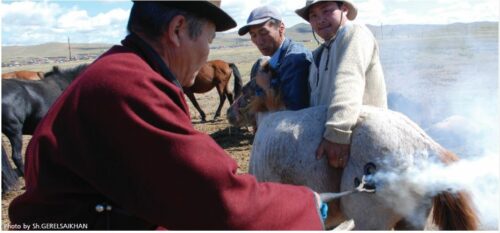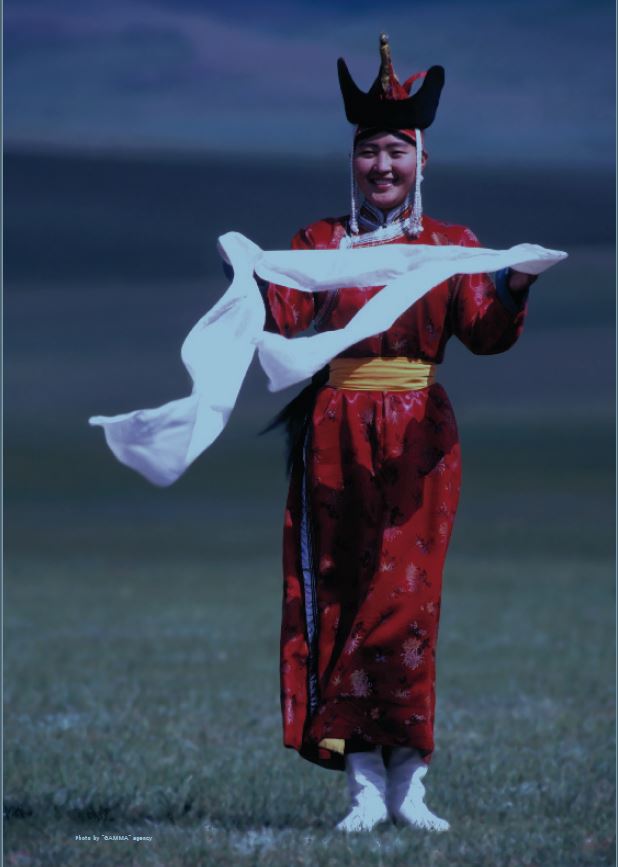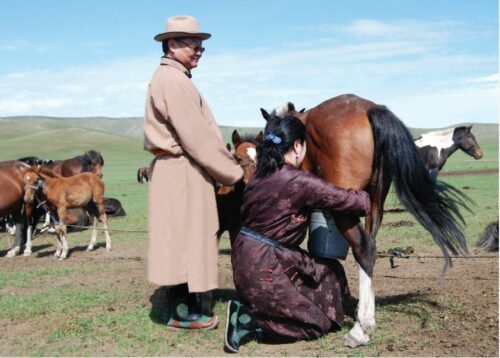Spring Endowment
With the arrival of spring and mild weather, livestock is emancipated, but pasture grass is still usually rare. Animals typically give birth in the spring, however, despite these conditions. This is the busiest and hardest period for livestock breeders. There is the Lunar Month festival which celebrates the passing of winter safe and sound. The spring endowment symbolizes the end of the hardships of winter and the welcoming of a new and favorable season. Our livestock breeders deem it necessary to undertake a ritual that symbolizes that everything in the universe is in coming forth, that the animals are producing their young, and that dairy products are available. They, therefore, perform a ceremony of bird or camel endowment at the end of spring and the beginning of summer. This is the celebration of welcoming an auspicious season after raising young animals well and increasing their animal population.According to the verses, “Do not go out to see the birds flying away; Do not come in when you see the birds flying back in”, it seems that birds flying away means sadness and birds coming back means happiness. The return of birds is a sign of coming good times. The following verses are recited during the bird endowment ceremony:
When the white pen comes
When the snow on the mountain melts
When the whitish yellow mare gives birth
Plenty of endowments may come
Hurray, Hurray, Hurray
When the swan comes
When drifts of snow thaw
When mares give birth
Fortune of endowments may come
Hurray, Hurray, Hurray
When the cuckoo comes
When the frozen earth thaws
When lambs are released from their tethering-line
The endowments may come
Hurray, Hurray, Hurray
The swan is considered to be a beautiful, lovely, and harmless bird. It is believed that if a swan cries while passing over a ger during its journey back in the spring, then that summer will bring happiness and plenty of dairy products.The verses of the endowment ceremony of the camel are similar to the verses of the bird endowment ceremony. It also symbolically welcomes the warm season and gives blessings to the newborn animals. The verses of the bird endowment ceremony are common among livestock breeders who live around many lakes and rivers and the verses of camel endowment ceremonies are common in the Gobi desert where there are many camels.
Mare Milking Ceremony
The milk libation ceremony is celebrated to greet the warmth of spring and to receive the newborn animals. But at the beginning of summer, the mare’s milking ceremony is performed as a sign of mare’s milk fermentation. Mongolians have a custom to tether their foals and colts on the Tiger Day, at the inception of summer, and release them from their tethers on the Dog Day of autumn. There is a custom to celebrate the occasion of fermenting mare’s milk with a feast, which is held within three days of the tethering. We rejoice with a feast when we release our foals and colts from their tethers in the autumn. Nearby catchers of horses gather together when the day of tethering arrives. The most venerated catcher of horses binds an honorable scarf to his lasso pole, catches the first born foal, and then hitches it to the first peg of the tethering-line.As soon as the tethering of foals and colts is over, the household invites those participants and hosts for a day of feasting mare’s milk fermentation.
After tethering, the household ferments their mare’s milk and preserves it. They also prepare dairy products for the feast of mare’s milk fermentation. Nearby acquaintances, friends, and relatives gather for the feast. Particularly, those who first participated in tethering foals and colts will come to the feast. They bring milk-vodka, shredded cheese curds, rendered cream, cottage cheese, and other dairy products as a contribution.
Before the feast celebration, a long white felt rug is spread out at the head of tethering-line. On the felt there is a table on which cooked cakes of flour are tiered. There is also a plate full of boiled mutton and vessels with mare’s fermented milk for offering, milk, milk vodka, among other foods and drinks. At the head of the table, a big wooden pail full of milk is brought. The wooden ladle with its long handle bound with five-colored scarves is placed over the top of the pail. The head of this ladle has nine square holes. This pail of milk and the ladle, which will be used in this offering, are placed to the west of the other products. All of these items need to be placed before the gathering horses.
The horses are gathered and brought to the tethering-line at sunrise. At first, the first born foal is caught and hitched to the tethering-line. When catchers finish tethering the foals they place their lasso poles in a row at the back of the ger. All gathered people can then enter the ger and have tea. Then they go out of the ger, where upon the milking of mare begins. The first mare is milked by a man. This is a vestige of ancient tradition. In Mongolia men used to milk mares in ancient times. The Secret History of the Mongols says, “Temujin went on in pursuit of a palomino gelding with its companions and when he came to the Bogurchu’s household, Bogurchu was milking a mare.”
After milking the mares, a milk libation ceremony is performed. In order to do so, nine men who ride grey horses are picked from those participants. The head of the ger (or household) can lead them. If nine horses of whitish colour are insufficient, seven or five horses can be used. The nine horsemen mount their horses and come to the door of the ger. The lady of the family then goes out of her ger and meets them holding a silver cup filled with milk. They should each taste the milk.
Those nine horsemen then go around the ger in a clockwise direction and come again to the felt spread out at the head of tethering-line. The head of the family slides the lasso pole through the two handles of the pail with milk and then two riders riding gentle horses carry the pail or pails. The head of the family can lead the horsemen. One rider from this group of horsemen takes milk from the pail with a ladle and makes a milk libation in all directions. In ordinary times, women make milk-libation using cow’s or ewe’s milk, but in special occasions like these, a man should make the milklibation. This is the basic difference.
When the mare’s milk-libation starts, participants ride their horses and follow the head of the family and other horsemen. They go around the tethering-line in a clockwise direction three times. The male head of the family starts chanting a poem related to mare’s milk-libation in a tuneful voice:
The reason to chant the milk-libation is the
Fortunate birth of the
Dappled mare;
Your milk has not yet been
Tasted by all,
Only your dappled foal
Has tasted it;
Even if you hold out your fingers
It can fill your palm with stretched fingers;
If we put a vessel under a mare’s udder
It can fill the vessel up to its brim; As an offering, We make this milk libation.
When the mare’s milk libation poem is recited, one of the riders makes an offering of mare’s milk and shouts, “May we satisfy the mare’s milk thirst!” Others join him. The riders go around the tethering-line in a clockwise direction three times and come to the door of the ger. They dismount and lean their lasso poles over the roof of the ger. They then bring the pail of milk into the ger and place it in the khoimor or most sacred place in the ger. After completing the milk libation, they bind one sacred scarf to the mane of a stallion and another to the neck of the first born foal. They carry a plate of tiered cakes and other food from the tethering-line. They say, “How heavy, let’s rest” and “Let’s move”. They prethem replies:
This is the weather
Which goes at the head
This is the weather,
Of the thousand sheep, Which is the best Of the ten thousand sheep.
Which is slain and blessed
With the libation of milk from a
Grey mare, which Bore a colt with a gold chest And silver hind quarters.
Then the plate of mutton and other products are offered to the head of the family. He assigns two people to place the tub of mutton and other products before the fermented mare’s milk container. These people slice the mutton and apportion a slice of mutton to each attendant, except for the portion of wether and the stomach. The wether is picked by hand and the stomach is cut and mixed with noodle soup. All those attendants share the resulting noodle soup. The stomach is a symbol of abundance; the wether is a symbol of firmness and strength.
Then the feast of mare’s milk-libation starts. The general proceeding is the same as other feast proceedings. But their contents are different. It reflects the manner and movement of tethering foals or colts and mare’s ferment milk-libation, for example.
It starts by describing the rain and the bounty of nature in the summer time, such as when nature is verdant due to the nutritional rain, which falls from dark blue clouds moving through the silver blue sky. It is on this verdant pasture that generous mares graze and their milk-yield increases:
The long tethering-line
Is stretched out in the north
The dappled horses,
Who have strayed over the valley
Are rounded up
You catch foals and colts like wild horses With long lasso poles
We also recite poems concerning mare’s milk libation, which use a particular poetic rhythm:
May your tethered foals and colts
Multiply like antelopes;
May your haltered foals and colts
Multiply like sand grouse;
May your dairy products cover the roof of your ger
And your domestic animals cover the valley; I raise this beneficent benediction
In such a manner we wish to increase the horse population and to make dairy products abundant.
Foal Branding Ceremony
When the weather becomes colder in autumn, the horse-breeders have a custom to set the mares and foals free of their halter and hobbles and to celebrate the feast of “Foal branding”. From ancient times, the feast used to have the name of the “Feast for foal branding”, due to the custom that horse-breeders used to brand the foals right before coiling the tethering line and letting them join their mothers. According to historical documents, since the establishment of the customs “Worship of Chinggis Qahan” in the late thirteenth century, the feast has been renamed to the “Feast for branding foals with tasam (the special “dash” brand) of Chinggis Qahan”.
Mongolians have a tradition to catch foals on Tiger Day, in the beginning of summer, and release them on Dog Day, at the end of autumn. In some localities the ceremony is called the “Feast of Chagt”. While the ceremony has general characteristics to those practiced throughout the nation, there are very distinctive elements that are defined by locality, ethnicity, and weather conditions. For instance, in some localities they do not release tethered foals and colts, thinking that tethered foals and colts in the autumnal frost will become more hardy. They release them at the beginning of winter or on the 25th day of the last month of autumn. Then they arrange a “Feast of Unhobbling”.
In order to perform this ceremony a fire is set in the vicinity of the tethering-line. An iron brand is made red hot. Each foal or colt is then branded, after which the brand is dipped into a pail of fermented mare’s milk. The pail is brought into the ger to be served. Guests are invited to enter the ger. They take their seats around the honored area of the ger to have food and drinks that were prepared for the foal branding ceremony. Prior to starting to enjoy the food and drinks, the head of the family takes a khadag (sacred silk scarf) and offers a benediction poem from the honored individual who had branded the foals and counted the horses. In response, that individual recites a benediction poem related to the custom of foal branding. A mare’s milk-libation is offered to heaven, earth and mountains. Thereafter, the feast for the “Custom of foal branding” continues according to established rules.Mongolians have a tradition to catch foals on Tiger Day, in the beginning of summer, and release them on Dog Day, at the end of autumn. In some localities the ceremony is called the “Feast of Chagt”. While the ceremony has general characteristics to those practiced throughout the nation, there are very distinctive elements that are defined by locality, ethnicity, and weather conditions. For instance, in some localities they do not release tethered foals and colts, thinking that tethered foals and colts in the autumnal frost will become more hardy. They release them at the beginning of winter or on the 25th day of the last month of autumn. Then they arrange a “Feast of Unhobbling”.



